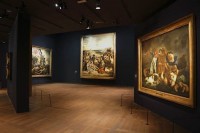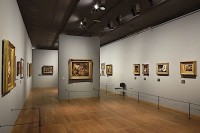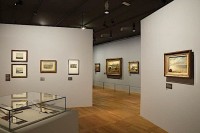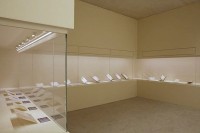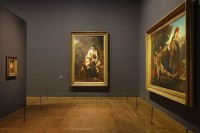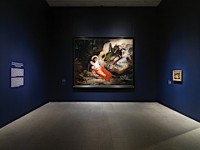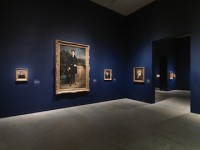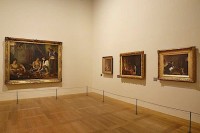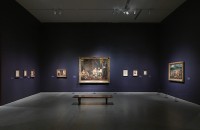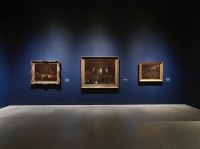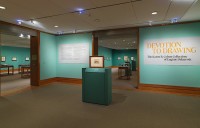The browser will either open the file, download it, or display a dialog.
Delacroix, 1798–1863
Musée du Louvre, Paris
March 29–July 23, 2018
Delacroix
The Metropolitan Museum of Art, New York
September 12, 2018–January 6, 2019
Une lutte moderne, de Delacroix à nos jours
Musée National Eugène Delacroix, Paris
July 28–December 3, 2018
Devotion to Drawing: The Karen B. Cohen Collection
The Metropolitan Museum of Art, New York
July 17–November 12, 2018
Catalogues:
Sébastien Allard and Côme Fabre, with Catherine Adam-Sidas, Dominique de Font-Réaulx, Michèle Hannoosh, Mehdi Korchane, Ségolène Le Men, Catherine Méneux, Asher Miller, and Marie-Pierre Salé,
Delacroix.
Paris: Musée du Louvre and Editions Hazan, 2018.
480 pp.; 305 color illus.; bibliography; index.
45€
ISBN 9782350316154
Sébastien Allard and Côme Fabre, with Dominique de Font-Réaulx, Michèle Hannoosh, Mehdi Korchane, and Asher Miller,
Delacroix.
New York: The Metropolitan Museum of Art, 2018.
314 pp.; 288 color illus.; bibliography; index.
$65
ISBN 9781588396518
Dominique de Font-Réaulx and Marie Monfort, with Julien Assoun, Emmanuelle Federspiel, Stéphane Guégan, Thierry Laugée, Véronique Milande, Alina Moskalik-Detalle, Paul Perrin and Valérie Sueur-Hermel,
Une lutte moderne, de Delacroix à nos jours.
Paris: Musée du Louvre and Les Editions Le Passage, 2018.
192 pp.; 112 color illus.; bibliography.
28€
ISBN 9782847423846
Ashley E. Dunn, with Colta Ives and Marjorie Shelley,
Delacroix Drawings: The Karen B. Cohen Collection.
New York: The Metropolitan Museum of Art, 2018.
176 pp.; 205 color illus.; bibliography; index.
$30
ISBN 9781588396808
The year 2018 had, a priori, no special relationship to Eugène Delacroix’s life or career; it was not, for example, a significant anniversary of the artist’s birth or death. The year went down, however, as one of the most important ever for commemorating the artist because of major retrospectives held at the Musée du Louvre and the Metropolitan Museum of Art. In addition, smaller exhibitions of the artist’s work were organized by both institutions: one devoted to Delacroix’s murals in St. Sulpice (which took place at the Musée Delacroix, a part of the Louvre), and the other devoted to a major donation to the Met of Delacroix drawings. These exhibitions benefitted from the restoration, completed in 2018, of two of Delacroix’s greatest religious paintings, the Pietà in the Church of Saint-Denys-du-Saint-Sacrement and the Christ in the Garden of Olives in the Church of Saint-Paul-Saint-Louis, and the recent restoration of the Chapel of the Holy Angels in Saint-Sulpice, completed in 2016. All four exhibitions, as well as their accompanying catalogues, are under review here.
One measure of the ambition of the show in the Louvre is that it did not really fit into the large space for temporary exhibitions in the Sully wing: not only were those galleries very full, but exhibition-goers were encouraged to see other paintings by Delacroix integrated into the permanent galleries. In the Sully space the exhibition followed a loose chronological order, with many galleries devoted to clearly identifiable themes, and some grouping together of paintings of different periods. Thankfully, it devoted much attention to the last fifteen years of the artist’s life, which do not always get their due in scholarship and exhibitions about the artist.
The show began in a sort of antechamber displaying, among other objects, early albums by the artist and a curiously featured painting, Tasso in the Hospital of St. Anna, Ferrara. Then came a dramatic large gallery with some of Delacroix’s best-known grand paintings: The Barque of Dante, Scenes of the Massacres at Chios, Greece on the Ruins of Missolonghi, and Liberty Guiding the People. To this group was added The Battle of Nancy, a lesser-known work because it normally resides in Nancy, but one which held its own in its august company, partly because it emphasized so clearly the artist’s early debt to the morbid side of Antoine-Jean Gros, but also because Delacroix updated battle painting, adopting troubadour-like elements from his smaller paintings and eliminating the hero. The installation ingeniously angled the paintings in order to keep groups viewing separate paintings apart, and thus maximize the exhibition space (a device not entirely evident in fig. 1).
Placing so many large, famous canvases in one of the first rooms was partly dictated, no doubt, by the exhibition space, which only has tall ceilings in the four corner galleries, but the arrangement proved felicitous. First, the paintings were hung one to three feet above the ground, allowing a close inspection of parts of the paintings that are normally at some distance from the viewer. Delacroix’s innovative, richly textural, and vividly coloristic technique in his early large-scale paintings was never more fully on display, and the paintings were easily compared with one another. Second, some spectators immediately got to see some of the main attractions, which perhaps removed the pressure to press ahead in search of the greatest hits.
Much of the rest of the exhibition—which was too large for a detailed account here—was composed of rooms with greater or lesser thematic unity. There was, for example, a gallery devoted to the Faust illustrations (a highlight because they display so well the idiosyncratic ways Delacroix began to treat bodies and physiognomies and his experiments with narration), a room with paintings related to the voyage to England, three adjoining rooms with Moroccan paintings and drawings from throughout Delacroix’s career, and galleries dominated by a particular type of painting: lion hunts, flower paintings (given unusual prominence), paintings of Christ’s Passion. Other rooms mixed related subjects: one contained early copies and studies of female nudes, studies related to the Chios and the Death of Sardanapalus, an assortment of small orientalist works, and two exquisite, small troubadour paintings (fig. 2). In the two final galleries of the show the diversity of the artist’s late work took over: visitors moved from Shakespearian to biblical subjects, and from scenes taken from mythology to scenes taken from novels. In the center of the last room, four free standing walls displayed a group of landscapes and seascapes in various media, emphasizing the importance of these genres and media for Delacroix in his private artistic life (fig. 3).
Delacroix’s status as a writer was stressed by directing viewers through a relatively narrow space, halfway through the exhibition, that opened into a small room lined with vitrines containing a selection of his manuscripts, including his famous journals (fig. 4). One might have feared that these hand-written, difficult-to-decipher documents would bore visitors, but in fact just the opposite seemed to be the case, and the quantity of documents, filled with Delacroix’s dense script, made clear the importance of writing to Delacroix.
Some works stood out as never before. The Murder of the Bishop of Liège hung on a free-standing wall in a small space all to itself. Freshly restored with amazing results, its mesmerizing composition, dramatic lighting, and captivating space and architectural detail worked their full magic. The inclusion of all the Faust illustrations made apparent the importance of the series and Delacroix’s early ambitions with lithography and the new approach to bodies and faces that he adopted at this time. The relative simplicity of modeling, shading, and color in the little-known St. Sebastian Tended by the Holy Women from Nantua had a stunning effect, particularly as it hung close to the nearly contemporaneous but very different and always profoundly moving Medea About to Kill Her Children (fig. 5). The juxtaposition of early and late Moroccan works made clear both how much Delacroix revised his ideas with this subject, and how he returned to certain subjects, details, and settings. Delacroix’s unique talent, within the nineteenth century, for manufacturing deeply moving images of Christ was already well known, but the display of so many of these paintings made clear their diversity of handling and effects. The Boston Lamentation appeared particularly experimental in this group because of its iconography (St. John), its handling, and radical tonal contrasts.
What might have been done differently? Given the space restrictions, it is too much to wish that the Salon version of The Death of Sardanapalus and The Entry of the Crusaders into Constantinople had been included in the main exhibition space. (They hung in the regular places in the permanent galleries.) Space might have been made, however, in one of the corner galleries for The Justice of Trajan, which would have made clear Delacroix’s efforts to maintain himself as a large-scale history painter at the Salon in the middle years of his career. Also, might more of an effort have been made to represent the importance of mural painting for the artist?
A few works begged some questions. The paint in The Basket of Flowers from Lille is handled very differently from that in the other flower paintings from around 1848. The flowers at the top of the bouquet are seen against a softly and gradually shaded background with none of the agitated handling and impasto seen in other similarly empty backgrounds; the strokes used to depict the petals are applied in a more regular, delicate, and formulaic fashion; and the range of hues is unlike the others. It is a beautiful painting, but why is it so different from the others? The Christ on the Cross from 1835 (Vannes) is remarkable for some of its iconographic innovations, but it tries too hard to be Flemish and has an additive quality in its accumulation of figures. The workman carrying the ladder is almost comically prosaic in relation to the rest of the composition. But these were minor disruptions in a show that zeroed in on the artist’s major achievements, selecting astutely from his enormous output. The curatorial expertise was clearly up to the level of the artist.
The New York incarnation was in important ways a different exhibition, partly by necessity. Imagine being asked to take a major retrospective exhibition that comes not only with the usual great risks and expenses, but also with the provision that it will travel without a number of the most famous paintings because of their size or fragility (The Barque of Dante, Chios, Liberty Guiding the People). Also, that the Faust prints—one of the unexpected highlights of the Paris show—were unavailable because their exhibition in Paris exhausted the amount of time they can be exposed to light. Several other major paintings could not travel because of donor restrictions (e.g., those in the Moreau-Nélaton bequest, including Greek Girl in a Cemetery and Still Life with Lobster). An entirely different selection of drawings had to be found because of restrictions on exposing them to light. Thus, the Met must be congratulated for finding over fifty alternative works and offering a different but equally successful organization. The Louvre version was the larger of the two, with some forty more works, but the New York version was plenty large. While the Louvre drew almost entirely on its own, unparalleled collection of drawings, the Met located an impressive selection of drawings in the United States and especially from the New York area.
The Met exhibition began, as in Paris, with a room that permitted the close inspection of large paintings, but in this case only Missolonghi and Christ in the Garden of Olives from Saint-Paul-Saint-Louis.[1] Thus, unlike in Paris, viewers were confronted with one well-known work (Missolonghi) and one that is hardly known by the general public (fig. 6). While Christ in the Garden of Olives has always been available to viewers in Church of Saint-Paul-Saint-Louis, it was not as visited and discussed as one might expect, at least partly because it hangs fairly high in the church and, until recently, was dirty and hard to see. In the Louvre, it hung in the main galleries, thus apart from the exhibition itself and at some distance from viewers. It only received its due in New York. The newly restored painting is a revelation for its palette, lighting effects (both around the main figures and in the background), rich impasto, and incidental details, as in the plants in the lower right of the canvas. (In comparison, it must be noted, Missolonghi seems desperately in need of a cleaning.) There is a daring in Christ in the Garden of Olives equal to the more illustrious early large-scale paintings, and one in which Delacroix was equally invested. It is also, however, an early religious painting, and therefore does not mesh easily with the introduction-to-art-history Delacroix that many people expect. Both deeply engaged with art historical precedents and highly innovative, its iconography raises all kinds of questions about Christ’s attitude toward the impending Passion and Delacroix’s attitude toward Christian doctrine. This is an early Delacroix that is different from the rebel, iconoclast, and Liberal, or the painter of atrocities, that many expect. One hopes that the room prepared viewers to discover a new Delacroix based on a direct experience of his work.
The next galleries took on a more biographical character than anything in Paris. There was a room filled with self-portraits, portraits of the artist’s friends and relatives, and various representations of past artists and writers. For all of his voracious appetite to explore every aspect of painting, Delacroix had limited forays into portraiture, but he invested great care in portraits of those he loved. These pictures made for an excellent juxtaposition with the fashionable portrait of Louis Auguste Schwiter, all style, suavité and anglophilia (fig. 7). Viewers were also offered the opportunity to compare Delacroix’s various depictions of his own artistic persona (as the dispossessed but dashing Ravenswood, or the later, imposing and inscrutable figure in Self-Portrait in a Green Vest) with three fascinating depictions of famous artists: Tasso in the Asylum (where the artist is melancholic and surrounded by insane men and abuse), Michelangelo in His Studio (where the artist is melancholic and perhaps possessed by ennui), and Ovid among the Scythians (where the artist lives in exile, surrounded by kind but uncomprehending barbarians).
Delacroix’s formation as an artist received greater emphasis by devoting a large room to studies, copies, academies, and early work that struck out in experimental directions, such as early orientalist and troubadour paintings. Another room explored Delacroix’s fascination with animals using many works not shown in Paris. Approximately one fifth of Delacroix paintings, and probably a much larger percentage of his drawings, were devoted to animals, but scholars have had little to say about them, making this a very welcome addition to the show. The diversity of his treatment of animals was on display in this room, and also in the ultimate gallery devoted to the 1855 Lion Hunt and related works, including the stunning Orsay sketch. The decision to include, both in Paris and New York, the surviving fragment of the painting from the Exposition Universelle, subsequently badly damaged by a fire, was surely a difficult one, but correct, I think. The fragment is missing the top half and part of the left-hand side of the canvas, but its broad handling—meant to be seen at a distance—and grim details make clear Delacroix’s ambition for this now overlooked work, which shocked and confused most critics when it was initially exhibited.
In New York there was an even greater exploration of Delacroix’s interest in printmaking, with prints interspersed in a number of galleries. To overcome the loss of the Faust illustrations, Asher Miller located another set in the Petit Palais, of which almost no one was aware and which has never been exhibited before. One reason the Bibliothèque Nationale series seemed irreplaceable is because Delacroix drew in the margins of some of the stones, sometimes in dialogue with the main image. These doodles were eliminated in the final prints but are preserved in some proofs. The proofs in the Petit Palais not only have all the marginal markings found in the set displayed in Paris, but also one more (though I have not had the opportunity to verify this), on the plate for Faust and Wagner. The Met also included a number of preparatory drawings for the series.
The display of North African subjects in the Louvre had emphasized the role of memory and the changes in Delacroix’s treatment of such subjects over the course of his career (fig. 8). In New York the emphasis was much more on the paintings Delacroix did shortly after his return. The Women of Algiers—the star of the New York show—appeared surrounded by related drawings (fig. 9). All three paintings Delacroix submitted to the Salon of 1834 were present, as were two early paintings of fantasias as well as the under-appreciated, Poussinesque Arab Players.
Many of the rooms in New York, which were in general larger than those in Paris, had correspondingly broader themes: “Scenes of Violence,” “Drama and Monumentality,” “Embracing Tradition,” “Land, Sea, and Sky.” There was a smaller room devoted to paintings of Christian subjects from the 1840s and 1850s, and again Delacroix’s brilliance as a painter of nature was dramatized by juxtaposing his studies of landscapes and seascapes with paintings that incorporate the sea or land into literary subjects. Something was perhaps lost, in the large rooms that mixed themes, for those unfamiliar with Delacroix in terms of separable, identifiable categories of subject matter, but something was gained in terms of felicitous comparisons and a demonstration of the breadth of Delacroix’s interests. Among the jewels added to the original show in these galleries were: Interior of a Dominican Convent in Madrid (happily juxtaposed with The Murder of the Bishop of Liège), The Natchez, and three marvelous studies for Jacob Struggling with an Angel in Saint Sulpice (fig. 10). The latter hung beside a drawing after nature of a tree that clearly served as the model for the foremost tree in the mural. The spacious hanging and elevated ceilings of the rooms in the Met provided for a very pleasant viewing experience; in retrospect, one becomes aware of how low the ceilings are in the Sully space in the Louvre. The only drawback of such tall ceilings is that the bright spotlighting descends at such a sharp angle, that it catches the top of cracks and impasto projecting out from the surface of paintings, sometimes resulting in unwelcome points of light that look like white spots on the canvas. Delacroix’s activity as a writer had a smaller presence in New York, but was included by displaying a notebook and a number of the journals in vitrines in the second and last galleries, accompanied by excellent translations.
The catalogue for the Paris show contains an essay that is essentially a book in itself on Delacroix by Sébastien Allard and Côme Fabre, followed by seven topical essays by other scholars, a brief biography, and a checklist with information about provenance and selected bibliography. The New York version omits three of the shorter essays and the biography, and obviously has a different checklist. Reproductions of the works not in the Parisian version are interspersed into the essay by Allard and Fabre. The translation of those essays originally written in French is in places inadequate. Research libraries will need both versions of the catalogue.
Allard and Fabre offer an account of Delacroix’s entire artistic career, drawing primarily on works of art in the exhibition. They divide his career into three phases: the first, from roughly 1822 to 1834, in search of glory, especially at the Salon; the second, from 1835 to 1855, devoted to large mural commissions; the third developing an interest in nature, the creative role of memory, and a sense of his place in history. These are somewhat arbitrary divisions: the Salon remained a focus for Delacroix through 1859, even if he stopped showing large canvases there after 1845 (or arguably after 1855); two of Delacroix’s most ambitious mural cycles, in the Hôtel de Ville (now destroyed) and in Saint Sulpice, belong to the period after 1855; and one might argue that his interest in memory and his own place in history developed over the entire course of his career. Nonetheless, they serve to illuminate key aspects of Delacroix’s oeuvre.
Allard and Fabre’s narrative portrays Delacroix in a number of ways. We see the development of crucial works in relation to the possibilities allowed by art institutions and the art market, to the expectations of critics, and to Delacroix’s own ambitions. We learn especially about the iconographic, stylistic, and literary sources that aided Delacroix as he developed his ideas. And we are offered numerous sensitive descriptions of individual paintings and some very pithy interpretations. There are brilliant observations and suggestions mixed in throughout: for example, in the first section the authors point out Delacroix’s tendency, in the 1820s, to divide his hero into two people and his penchant to leave the hero on the margins, upstaged by collective suffering; it suggests that many paintings of massacres done during this period might be considered as displacements of Revolutionary and Napoleonic violence. The section on the flower paintings from circa 1848 is very original—it is the first analysis to fully flesh out their relation to past floral still lifes and correctly notes the ways in which they allowed Delacroix to think about the use of color in his murals—but this is very much done in the source-hunting mode of much of the rest of the essay. Pursuing the interpretation of the luxurious still lifes as an escape from, or riposte to, the contemporaneous political upheavals in France is labeled as “risky” (137).
In some ways Delacroix’s work begs for such an approach because of the artist’s immense learning, wide reading, obsession with art history, and tireless looking at other artists. He was an intellectual, if a sensuous one, to the core. Allard and Fabre are equipped with the sensitivity and rich literary and art historical knowledge to deal with these aspects of Delacroix. And yet, might there also be a way to include in their narrative an acknowledgement of the many other innovative ways in which Delacroix has come to be understood in the last few decades? Recent characterizations of emulation and tradition might help explain Delacroix’s peculiar immunity to the self-doubt and feelings of belatedness that plagued so many of his contemporaries. In the “Introduction” to the French catalogue (omitted from the English one), Allard and Fabre assert that “Often invoked as the natural ancestor of avant-garde colorists, Delacroix follows in reality a course that is not very compatible with a formalist and modernist reading of the history of art” (17). This might have led somewhere in the catalogue to a brief consideration of Delacroix’s peculiar position in relation to modernism: always cited as the most important artist of his generation for modernism, yet generally excluded from it. Despite the fact that the writers are obviously versed in theories of modernism, they eschew all theoretical questions and explanations.
Most surprising in this regard is the almost complete elision of postcolonial and other identity-oriented approaches to Delacroix, including issues of race, sexuality, and gender. Such interpretations are so well-known that they do not need to be rehearsed here, in a publication for specialists. Allard and Fabre might be excused if they were searching for a way to rejuvenate scholarship on Delacroix by offering an alternative to a mode of interpretation that has dominated writing on the artist for decades, and that has sometimes been applied to him facilely. But to refuse to consider such ideas, or to remove them from the record, seems inexcusable, particularly because, overall, such interpretations have surely made Delacroix more interesting to more people than any other recent approach.[2] It would be nice to have some exploration of the relationship between Delacroix’s art and ordinary people’s social, political, or personal lives, in addition to addressing more purely academic concerns. Good scholarship that relates Delacroix’s work to issues of identity and politics is generally not an argument to relegate his paintings to the reserves; rather it is an invitation to engage with them in new ways and from the point of view of more people. To move forward, instead of backward, some acknowledgement of, or better yet, some grappling with the implications of recent scholarship is necessary. Finally, Delacroix’s vision of civilization and modernity was increasingly dark and pessimistic. His views on sexuality, human’s potential for violence and domination were—and still are—deeply disturbing. But these aspects of the artist are lost if one refuses to enter into the questions they raise.
Monographic exhibitions focused on pre-Impressionist artists are rarer than they once were. Concerns about money, relevancy and accessibility have diminished their numbers. Possibly they are an endangered species, and it would be a tragedy, in my view, if they disappeared. Perhaps their catalogues require the traditional art historical apparatus, or perhaps only those enamored with that apparatus are in a position to produce such exhibitions. Certainly, the public in general wants to know that they are being shown a great artist, even a genius, and traditional art history is very good at establishing this. And no matter in how many ways the author is said to have died, most scholars still enjoy contemplating great individual achievements in the arts. But I am left wondering if there exists a more inclusive or experimental approach that might renew this type of catalogue. Allard and Fabre do what they do extremely well, so it is not a matter of doing it better. It has been difficult to find new models. Models that have completely dismissed tried and true approaches have often failed to find a sustaining public.[3] A viable solution would seem to depend on a mixing of modes.
Allard and Fabre do offer something in this regard: the inclusion of the seven brief essays that follow their own. Two are written by art historians who have transformed the field. Michèle Hannoosh’s work has completely changed our understanding of Delacroix’s practice as a writer and even the corpus of this writings. No one is better able to describe the literary Delacroix better than she, especially in a short essay. Similarly, who better than Ségolène Le Men to explain Delacroix’s various uses of printmaking, given her own attention to all forms of printed culture in the nineteenth century? Other essays provide fresh examinations of various aspects of Delacroix’s career. Asher Miller contributes an excellent exploration of the ways in which Delacroix deployed the act of looking, both by the figures in his paintings and by the ways in which he engages the viewer. He also calls attention to the repeated presence of death in the artist’s depictions of mothers and children. Mehdi Korchane offers a new and perceptive analysis of Delacroix relationship as a student to Pierre-Narcisse Guérin and Gros before and during the years he established his own artistic reputation. Dominique de Font-Réaulx recounts the history of Delacroix’s retrospective exhibition at the Exposition Universelle of 1855, emphasizing the artist’s own role in curating it. Two other essays, on Delacroix’s use of pastel and the history of his critical reception during his lifetime, come from Marie-Pierre Salé and Catherine Méneux, respectively. All of this makes for a catalogue whose weight alone seems a tribute to the talent, productivity, and complexity of Delacroix.
The exhibition at the Musée Delacroix faced a challenge every bit as daunting as the one that confronted the Met: how to make a splash with the behemoth across the river already stirring the waters. Museums devoted to single artists, of which there are many in France, always have the difficult task of keeping themselves relevant and visitors coming. During her tenure as director of the Musée Delacroix, Dominique de Font-Réaulx has done a marvelous job of doing just that, not simply by growing the collection and restoring the buildings and grounds, but also by mounting exhibitions and programs that seek to broaden the museum’s public. In light of my comments above, the exhibition that opened the 2018 season is of particular note: in collaboration with the Lilian Thuram Foundation, which promotes education against racism, the museum mounted an exhibition entitled “Real and Imaginary Depictions of the Orient: a Matter of Gazes.” The show consisted of Orientalist works by Delacroix and others accompanied by short, accessible commentaries by the feminist Françoise Vergès and the legendary footballer Lilian Thuram, who is of Guadeloupian and African descent. Their comments did not shy away from questions of race and gender.
To accompany the Louvre show, de Font-Réaulx had the excellent idea to focus on the newly restored murals in Saint-Sulpice, which are a short walk from the museum and could not, of course, figure in the Louvre show. The exhibition consisted of works of art that served as sources for Delacroix, previous works by the artist that bear some relation to the Saint Sulpice murals, studies for the murals, and works by other artists inspired by the murals. It makes abundantly clear the immense and wide-ranging research that Delacroix habitually undertook for major mural commissions. Some of his sources, for example Jean Duvet’s sixteenth-century engravings of Apocalypse, are surprising, but the catalogue demonstrates convincingly the role they played in the genesis of Delacroix’s paintings. The many works in the show drawn from Delacroix’s source material beautifully demonstrate the intensely art historical nature of his creativity.
The catalogue consists of eight essays as well as catalogue notices for the objects in the show. Marie Monfort provides an overview of the art historical understanding of the murals, particularly as this pertained to their restoration. Alina Moskalik-Detalle and Julien Assoun (the former led the group doing the actual restoration; the latter was a member of the team) offer precious testimony about their work, which was complicated by superimposed layers of wax and oil and earlier restorations. Notwithstanding these, they found Delacroix’s own work largely intact, and they confirm that the procedures used to create the work corresponds to the account Delacroix gave himself in his journal and correspondence. Among other discoveries: the work in the spandrels is clearly from the hand of Delacroix. Valérie Sueur-Hermel discusses the prints that may have served as sources for Delacroix, adding some new possibilities to this much-studied subject. This essay has the merit of demonstrating the key role that prints played not only in Delacroix’s creative process, but also in the ways in which viewers responded to his work. Indeed, critics entered into a frenzy of source hunting in front of the murals, suggesting how much viewing practices at the time relied on an iconographical knowledge developed largely from prints, one that is difficult for us to appreciate today.
Stéphane Guégan broaches a vastly understudied aspect of Delacroix: his attitude toward religion. Recent efforts to turn Delacroix into a covert reformulator of Catholicism are clearly overstated, and yet the artist confessed, especially toward the end of his life, to spiritual yearnings and even a belief in god. He also found himself increasingly horrified by modern proposals that purported to find entirely rational, secular bases for morality or the organization of society. And, of course, his paintings of Christian subjects are among the most moving of the nineteenth century. Guégan is eloquent on the pictures of Christ dead or in agony from the 1840s, and he makes abundantly clear the interest of his subject. Thierry Laugée returns to the subject of Delacroix’s attitude toward Christianity in his essay, which focuses on the surprising links between the artist’s practices as animal painter and as a religious painter. Both essays point to the need for an extensive study of the changing significance of religious painting and its reconfiguration in relation to other artistic genres and practices, both in the art of Delacroix and more generally in painting in the middle decades of the century.[4]
In her essay, Dominique de Font-Réaulx explores the origins of the murals’ subjects and iconography, in particular in overlooked antique Greek sources and within Delacroix’s own oeuvre. She, too, offers sensitive observations, in part permitted by the restorations, regarding the ways in which the murals interact with one another formally. In the catalogue’s last essay, Paul Perrin studies the paintings inspired by the St. Sulpice murals during the four decades following their completion. On the one hand, Delacroix’s murals motivated other artists—including Alexandre Leloir, Léon Bonnat, Gustave Moreau, Paul Gauguin, Maurice Denis, and Odilon Redon—to take up the subject of Jacob wrestling the angel, even if they took the subject in very different directions. On the other hand, Pierre-Auguste Renoir, Vincent van Gogh, Paul Signac, and Georges Seurat drew a variety of formal lessons from them.
The final exhibition under review celebrates the very generous donation of Karen B. Cohen’s collection of over 130 drawings by Delacroix to the Met. The gift makes the Met’s holdings of the artist’s work the largest outside of Paris. What is most striking about the collection is the breadth of types of drawings in it: academic studies, écorchés, copies after prints, paintings and photographs, tracings, landscape drawings, visual records from travel, animal studies, caricatures, premières pensées, varied experiments with a particular motif, detailed studies for paintings, drawings from memory, doodles, and drawings for transfer to lithography. Delacroix’s technique is just as varied: rapid sketches and carefully finished line drawings, spontaneous ideas, and highly cogitated compositions, acutely naturalistic renderings and extremely expressive sketches that are barely legible. The collection, supplemented with a number of prints and drawings offered for comparison, fit perfectly into the rooms normally used for exhibitions of works of paper at the Met (fig. 11). It was divided into a room grouping primarily student exercises, écorchés, and copies after old Masters, another displaying primarily drawing used to develop ideas or record motifs for paintings, and finally a room devoted to drawings related to printmaking, wash drawings, and watercolors. The array of techniques, from the most spontaneous, rapid ink drawing, to the most careful tracing, was truly astounding. In one watercolor, Goetz von Berlichingen Being Dressed in Armor by his Page George, one sees paint with different additives used for texture and to thicken the paint, wax resists used for patterns in the background drapery, gouache, and layering of paint.
Ashley E. Dunn’s catalogue essay uses the work in the collection to explain the many uses to which Delacroix put drawing. She is particularly good at establishing the important role that tracings (which have not been much prized by collectors and hardly studied) played in his work. Dunn quotes a surprising passage in the Journal in which Delacroix prefers one of his tracings to the drawing from which it was taken, because the former shows his “intentions [. . .] more clearly.” He goes on: “I have introduced the degree of elegance that I felt was needed to render a true impression of the subject. This process of idealization happens almost without my realizing it whenever I make a tracing of a composition that comes out of my head. The second version is always corrected and brought closer to the necessary ideal” (41). This observation is astonishing partly because the standard connoisseurship of the artist values the multiple contours and frequent re-working commonly found in Delacroix’s drawings, and the spontaneity and dash of his rapid pen sketches.
Delacroix’s activity as a draughtsman was essentially unknown by the public during his lifetime, but sprang to the attention of his admirers at the sale of his studio following his death. Despite his continuing fame in this regard, there is surprisingly little scholarship on the drawings that goes beyond admiration, making Dunn’s efforts all the more remarkable. In addition, the catalogue contains an essay by Marjorie Shelley that offers a discerning account of the materials and techniques Delacroix preferred. As she notes, Delacroix generally used simple, readily available graphic media: charcoal, graphite, ink (especially), chalk, watercolor, pastel, and often on ordinary writing paper. He could use these in innovative ways, and he moved easily between media. There is also a brief essay by Colta Ives recounting the history of collecting Delacroix at the Met.
Because this review appears ex post facto and in an academic journal, I have taken the opportunity to offer a few criticisms, particularly of the catalogue for the retrospective, not, I hope, according to the usual formula of quibbling a bit with this or that before concluding with a hearty endorsement, but because the seriousness of the efforts invites serious questions. That said, let me end with an endorsement. Delacroix is an artist in danger of drowning in the clichés surrounding his work. At the moment I write (November 2018), it is disturbing to see the number of reviews that never get beyond the usual clichés: Delacroix as Romantic rebel, passion painter, consummate Parisian, friend of Frédéric Chopin and Georges Sand, contemporary of Lord Byron, Victor Hugo, Honoré Balzac, and Walter Scott, rival of J.-A.-D. Ingres. There is the old paradox of a Romantic who was also a Classicist, the same old rumors about Talleyrand being his father, the usual quotations from Charles Baudelaire. So famous are some of Delacroix’s works that some critics of the New York version of the retrospective spent their time discussing them instead of the work actually in the show. Many never moved past the warhorse canvases of the 1820s and 1830s. While it is now standard fare in reviews to recap the critiques of the artist’s attitudes toward women and North Africa, virtually no one entered into the artist’s conservative views in the last decades of his life, apparently more comfortable with the rebel of the Restoration, whatever his flaws, than the negator of progress who emerged in the 1840s and 1850s. Most prevalent of all was the cliché that Delacroix’s work equals color. The point is not that none of these is true, but that good exhibitions will go beyond these to bring out new or unexpected aspects of an artist. The great merit of all these shows, but particularly those in the Met and the Musée Delacroix, is that they allow—perhaps even force—viewers to discover a less well-known Delacroix, and that they display the work straightforwardly, in ways that allowed it to speak for itself. There was thankfully no effort to fulfill the clichés, nor to supplement Delacroix’s work with that of more modern artists. There was no effort at garish display, no white walls that would make it appear more contemporary. Granted that the complexity of the artist put on display in the retrospectives in the Louvre, and especially the large, multi-themed galleries of the Met, may have been difficult to grasp, but hopefully there is still an audience for some of the most difficult art that the nineteenth century has to offer.
David O’Brien
Professor, University of Illinois
obrien1[at]illinois.edu
[1] Each was loosely juxtaposed with smaller works, on adjoining walls, that made for suggestive comparisons: the Head of an Old Greek Woman from Orléans and the Wounded Bandit from Basel. The former in some ways makes up for the absence of the unforgettable Young Orphan in a Cemetery, as it is not as well-known but has a similar and equally fascinating treatment of the eyes.
[2] A few references are made to Darcy Grimaldo Gridgsby, Extremities: Painting Empire in Post-Revolutionary France (London: Yale University Press, 2002); and Malika Dorbani Bouabdellah, Eugène Delacroix: Femmes d’Alger dans leur appartement (Paris: Musée du Louvre and Somogy, 2008) is in the bibliography. No mention is made of Darcy Grimaldo Grigsby, “Orients and Colonies. Delacroix’s Algerian Harem,” in The Cambridge Companion to Delacroix, ed. Beth Wright (Cambridge: Cambridge University Press, 2001), 69–87; François Pouillon, “L’Ombre de l’Islam: les figurations de la pratique réligieuse dans la peinture orientaliste du XIXe siècle” in Actes de la recherché en sciences sociales, no. 75 (November 1988): 24–34; Todd Porterfield, The Allure of Empire (Princeton: Princeton University Press, 1998); Linda Nochlin, “The Imaginary Orient,” in The Politics of Vision: Essays on Nineteenth-Century Art and Society (New York: Harper and Row, 1991), 33–59; Mary Harper, “The Poetics and Politics of Delacroix’s Representation of the Harem in Women of Algiers in their Apartment” in Picturing the Middle East: A Hundred Years of European Orientalism, A Symposium (New York: Dahesh Museum, 1996), 52–65; Joan DelPlato, Multiple Wives, Multiple Pleasures: Representing the Harem, 1800–1875 (Madison and Teaneck, NJ: Fairleigh Dickinson University Press, 2002); Deborah Cherry, “Algeria in and out of the Frame” in Visual Culture and Tourism, ed. David Crouch and Nina Lübbren (Oxford and New York: Berg, 2003), 41–58; Elisabeth Fraser, Mediterranean Encounters: Artists between Europe and the Ottoman Empire, 1774–1839; idem., “Images of Uncertainty: Delacroix and the Art of Nineteenth-Century Expansionism,” in Cultural Contact and the Making of European Art since the Age of Exploration, ed. Mary Sheriff (Chapel Hill: University of North Carolina Press, 2010), 123–51; Laurel Ma, “The Real and Imaginary Harem: Assessing Delacroix’s Women of Algiers as an Imperialist Apparatus,” Penn History Review 19:1 (Fall 2011): 9–26; and Ralph Ubl, “Delacroix’ Jewish Wedding and the Medium of Painting”, in Judaism and Christian Art, ed. Herbert Kessler and David Nirenberg (Philadelphia: University of Pennsylvania Press 2011), 359–88.
[3] As one example, witness the exhibitions of Régis Michel from almost twenty years ago. Michel is fond of saying that the history of art is dead—and no doubt he would find the present exhibitions to be the work of the living dead—but his own intervention reveals how difficult it is to find new models that work. Michel produced two extraordinarily innovative, even iconoclastic exhibitions and catalogues: Posséder et détruire. Stratégies sexuelles dans l’art d’Occident (Paris: Réunion des Musées Nationaux, 2000); and La Peinture comme crime, ou la part maudite de la modernité (Paris: Réunion des Musées Nationaux, 2001). While these seized the attention of intellectuals and ignited intense, much needed debate among specialists, they failed to attract audiences sizable enough to justify more like them. Perhaps the Musée de Louvre was relieved to stop the experiment, but the fact remains that Michel’s exhibitions were discontinued because of the same criteria that threaten the traditional monographic show: money, accessibility, relevancy.
[4] On Delacroix’s religious paintings, there is Delacroix: peintures et dessins d’inspiration religieuse (Paris and Nice: Editions de la Réunion des Musées Nationaux and Musée National Message Biblique Marc Chagall, 1986); Joyce Polistena, The Religious Paintings of Eugène Delacroix (1798–1863): The Initiator of the Style of Modern Religious Art (Lewiston, NY: The Edwin Mellen Press, 2008); and Bruno Foucart, Le Renouveau de la peinture religieuse en France (1800–1860) (Paris: Arthéna, 1987), 118, 127–28, 244–49, and 321–22. Yet, more could be done to fit his paintings into not just theological and other changes within the Catholic Church, but instead broader shifts in religious sentiment, secularism, and humanism.


